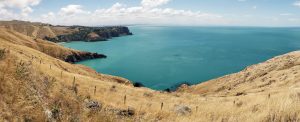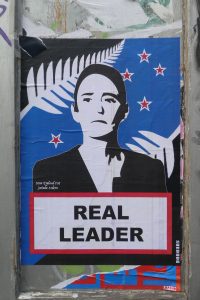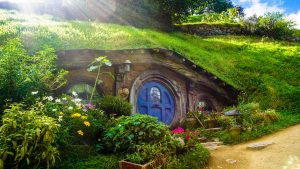25 Pacific Realm: Population Geography – COVID-19 in New Zealand
Sometimes there are advantages to being an island country. Of course, there may be disadvantages too. You can’t drive to the islands that are Japan nor to Iceland nor Fiji nor New Zealand. (Now you can drive through the Chunnel (the tunnel under the English Channel) from France to England. Cost of living often is higher on islands, due to the additional costs of transporting products to an island. Islands face the factor of isolation.
Nevertheless, isolation can be a good thing. In the global pandemic of COVID-19, isolation can be a positive factor. At least theoretically, island countries or territories have the possibility of blocking all travel to and from their island. As you will read in Chapter 76, attempts to close an island may fail, as they did for Puerto Rico. Clearly for a pandemic, land borders are much more difficult to monitor than are sea and air borders. As we see from America’s current attempt to build a wall along its border with Mexico, land borders may be crossed in a variety of means. To arrive in an island country, you need a boat or an airplane.

New Zealand is an island country, featuring two main islands for nearly all of the populace. It has a population of nearly five million people. In addition to the inherent isolation of being an island country, New Zealand’s remote location places it far distant from almost every other place on the planet. To fly to nearby Australia is to travel nearly 2600 miles. Yes, that’s right, the proximity of its nearest prominent neighbor is like the distance from Los Angeles to New York City.
This makes New Zealand an ideal location for a demographic and medical experiment. How would a contagious disease spread through an island country of five million people? Naturally, no one would set this up as a real experiment. Computer simulations could be run. However, COVID-19 made this a reality.

The first documented case of COVID-19 in New Zealand was on February 28, 2020. The initial cases of the virus were travelers who had returned from Iran or Italy. New Zealand’s government instituted a nearly complete shutdown of the country for March 24 to April 9, followed by very gradual relaxation of restrictions. International travel was highly regulated, so that New Zealand citizens could return to the homeland but would face a two-week quarantine upon arrival. Foreigners were not allowed to enter the country. New Zealand instituted very active measures for virus testing and in contact tracing. The country tallied 1504 cases, but only 22 deaths. New Zealand now has no new cases of the coronavirus, in fact, no new cases for over two weeks.
According to worldometers, on June 11th, 2020, New Zealand was the second most populated country that has no active cases of COVID-19 (Papua New Guinea was the most populated such country.). Of the 22 countries/territories with no active cases of the virus, 19 are islands. The exceptions are Laos, Montenegro, and the microstate of Vatican City.

New Zealand Prime Minister Jacinda Ardern is very popular in her country, actually the most popular there in the past century. In mid-May 2020, a Newshub poll asked people if they felt that the nationwide lockdown was the right call. The poll revealed that 91.6% of respondents said “Yes.” I doubt if we could find any national political action to have 90% support of Americans.
As revealed in Chapter 23, in several ways Iceland is northern hemisphere’s version of New Zealand. The parallels continue with the coronavirus, as Iceland had only 3 active cases on June 11th and only 1807 total cases.
Did You Know?
Here is a Kiwi popular pandemic joke. Note that Aotearoa is the native name for the land there.
God was spotted in New Zealand.
Someone asks: “What are you doing in Aotearoa, God?”
“Working from home, bro!”
New Zealand Prime Minister Jacinda Ardern picked up Stephen Colbert at the airport, as featured on The Late Show with Stephen Colbert. https://www.youtube.com/watch?v=DUPo62ouU84
Would shelter-at-home seem like living in small tucked-in homes?

Cited and additional bibliography:
Cave, Damien. 2020. “New Zealand Lifts Lockdown as It Declares Virus Eliminated, for Now.” The New York Times, June 8, 2020, sec. World. https://www.nytimes.com/2020/06/08/world/australia/new-zealand-coronavirus-ardern.html.
“COVID-19 CORONAVIRUS PANDEMIC.” 2020. June 11, 2020. https://www.worldometers.info/coronavirus/?utm_campaign=homeAdvegas1?%22.
duncan c. 2019. Jacinta Ardern, Prime Minister, New Zealand. https://tinyurl.com/JacindaNZ. Attribution-NonCommercial 2.0 Generic (CC BY-NC 2.0).
Lynch, Jenna. 2020. “Newshub-Reid Research Poll: Overwhelming Number of Kiwis Back Government’s Lockdown Decision.” Newshub, May 18, 2020, sec. Politics. https://www.newshub.co.nz/home/politics/2020/05/newshub-reid-research-poll-overwhelming-number-of-kiwis-back-government-s-lockdown-decision.html.
Richter, Konstantin. 2020. “How New Zealand Beat the Coronavirus.” POLITICO. May 14, 2020. https://www.politico.eu/article/kiwis-vs-coronavirus-new-zealand-covid19-restrictions-rules/.
Shepherd, Marshall. 2020. “How Geography Helped New Zealand Beat Coronavirus.” Forbes. August 10, 2020. https://www.forbes.com/sites/marshallshepherd/2020/08/10/how-geography-helped-new-zealand-beat-coronavirus/#1037ebb44215.
Sternlicht, Alexandra. 2020. “How New Zealand ‘Eliminated’ Coronavirus.” Forbes. June 8, 2020. https://www.forbes.com/sites/alexandrasternlicht/2020/06/08/how-new-zealand-eliminated-coronavirus/#4530d47d1bbd.
Westcott, Ben. 2020. “With No Active Covid-19 Cases, New Zealand Is Lifting Almost All Its Coronavirus Restrictions.” CNN. June 8, 2020. https://www.cnn.com/travel/article/new-zealand-coronavirus-level-one-intl-hnk/index.html.
Wiertz, Steve. 2020. “New Zealand.” College of DuPage GIS class. Instructor Joseph Adduci.

